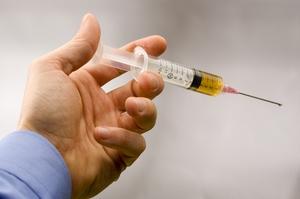Pentagon shifts $1 billion from WMD-defense efforts to vaccine development
The Obama administration has shifted more than $1 billion out of its nuclear, biological, and chemical defense programs to underwrite a new White House priority on vaccine development and production to combat disease pandemics; Defense Department projects under the budget-cutting ax include the development and acquisition of biological and chemical detection systems; gear to decontaminate skin and equipment after exposure; systems to coordinate military operations in a chem-bio environment; and protective clothing for military personnel entering toxic areas, the document indicates

A greater emphasis on biological defense // Source: masternewmedia.org
The U.S. Defense Department has shifted more than $1 billion out of its nuclear, biological, and chemical defense programs to underwrite a new White House priority on vaccine development and production to combat disease pandemics, according to government and industry officials.
The planned funding reduction “terminates essential CBRN [chemical, biological, radiological and nuclear] defense programs … required to meet high priority service needs, prevent casualties and protect against CBRN incidents,” according to a Pentagon budget document drafted in early August.
Global Security Newswire’s Elaine M. Grossman writes that internal deliberations over the budget have been ongoing for months as the government prepares to submit its fiscal 2012 spending request to Congress next February. “To implement the DOD response to the president’s new [vaccine] initiative requires $1.07 billion” between fiscal 2012 and 2016, states the defense memo, obtained by Global Security Newswire.
The money was taken out of a wide variety of programs deemed “essential” for combating weapons of mass destruction, the document states. An additional $442 million was trimmed through efficiency reductions mandated by Defense Secretary Robert Gates, for a total of $1.5 billion cut from the counter-WMD account over the five-year period, according to the draft memo.
Defense Department projects under the budget-cutting ax include the development and acquisition of biological and chemical detection systems; gear to decontaminate skin and equipment after exposure; systems to coordinate military operations in a chem-bio environment; and protective clothing for military personnel entering toxic areas, the document indicates.
Grossman writes that the early-August appeal, drafted by Andrew Weber, the Defense Department’s senior official responsible for WMD defenses, was aimed at securing funds from the Pentagon comptroller to replenish the affected programs. She notes that a Pentagon spokeswoman said neither Weber nor anyone from his office was available this week for interview.
“By diverting $1 billion from nonmedical [chem-bio] defense programs to this medical vaccine facility on top of the OSD efficiency cuts, Weber threatens to return the military forces to a state of unpreparedness that we haven’t seen since 1996,” said one longtime defense analyst, referring to the Office of the Secretary of Defense. Lacking permission to discuss internal government debates over budget plans, the source asked not to be named.
Grossman says that the memo reportedly has since been superseded by another, more limited plea, which instead seeks restoration of less than one-third of the eliminated WMD-defense funds. The subsequent document also omits mention of the high-priority White House vaccine project, sidestepping what might be regarded as implicit internal criticism of the Obama funding priority on the Medical Countermeasures Initiative, the defense expert said. Led by the Health and Human Services Department, the new program aims to expand the U.S. capability to make lifesaving vaccines.
The latest budget memo constituted “an attempt to pretend that [there] wasn’t a [funding] trade between [the vaccine initiative] and the nonmedical projects,” the defense analyst told Grossman. “No matter what [budget] memo gets up to the comptroller … there still is a $1 billion reduction in nonmedical R&D and a $1 billion increase in [the Medical Countermeasures Initiative].”
The issue could become politically contentious when the Obama budget request moves up to Capitol Hill early next year and industry advocates begin lobbying on the matter.
